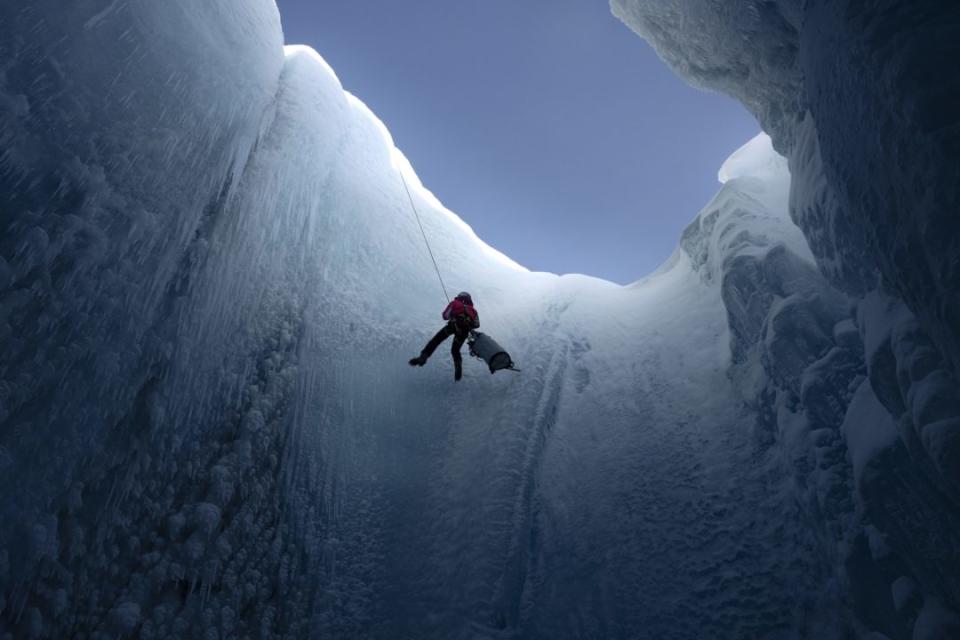Deep inside Greenland's melting ice cap, the situation is dire
The rocks at the edge of the ice looked more like someone had backed up a gravel truck and dumped it rather than the remnants of what had once been encased deep in a glacier.
Picking my way through the piles and onto the Greenland ice cap itself during a StormHunters expedition back in 2013 was a crash course in not breaking an ankle. Gravel mixed with meltwater and crumbling ice poured past my feet and I wondered if what I was seeing was regular summer melt, or if this was one of the first signs of a serious problem.
Lucky for me, a powerful new documentary called Into The Ice answered my question — but the answer wasn’t the one I’d hoped for.
Into The Ice, a film by documentarian Lars Ostenfeld, took him high up onto the Greenland ice cap as he followed three sets of scientists delving deep into the frozen surface.
As Ostenfbeld explained, when I spoke with him over a video call in advance of the film’s screening at the Planet in Focus Festival, getting a better look of what’s happening inside the glacier is an important as seeing what the satellites are telling us.
“Half of the ice melt is happening inside the ice and we have no idea what’s going on in there. The satellites and the radar are only seeing the surface and that’s where our knowledge is coming from,” he told The Weather Network.

On the ice caps of Greenland during the filming of Into the Ice. (Courtesy of Lars Ostenfeld)
So, to understand how the ice is changing and document how climatologists are finding new ways to document those changes, Ostenfeld travelled across the ice cap with Jason Box, dropped into a deep moulin (a meltwater hole in the ice) with Alun Hubbard, and examined ice cores with Dorthe Dahl-Jensen.
Each section of the documentary has its share of adventure, but it’s the section where Ostenfeld descends into the moulin that had my heart going (and I’ve been inside live volcanoes).
I asked Ostenfeld what emotions were going through his mind as he stood at the edge of the ice.
He laughed as he told me, “First of all, it was a good idea back in Denmark to climb down in the moulin. It sounded like a great adventure, but when I was standing there at the edge, looking down, it was totally black. You could see the ice and it just went down into a black hole. Nobody knew how deep it was and nobody knew where it ends. That was scary.”
Watch also: 'Zombie ice' is threatening our seas, but what is it?
Heading down into the moulin was dangerous beyond anything he’d ever done before.
“We took it in slow steps,” he said. “When I was down at 60 metres there was a small plateau and I could stop and film from there. I was scared: very, very scared. My knees were shaking, my heart was going, but my safety guy, and expedition leader, was right beside me and the way he spoke to me, and the way he handled things made me feel safe.”
Getting to the bottom was a goal for both Ostenfeld and the scientists. For the former, getting a shot from the bottom of the hole would be potentially a first in filming, and for the scientists, and it was a chance to determine how much melt was ongoing within the ice cap.
On his first attempt, Ostenfeld only made it part of the way down as Alan Hubbard, his companion glaciologist, decided the ice was too warm and dangerous to make it all the way to the bottom. On the second attempt, spoiler alert, the scene had my stomach in knots while watching the film.
At the end of the day, the real point of the documentary wasn’t to have an adventure, but to make people feel the effects of climate change.
“It is happening and I want people to feel it and take it seriously. This film celebrates science and the scientists and I want people to listen to what they are saying. It's like a Cassandra complex: you know what’s happening in the future but you feel like no one’s listening. And I want people to listen to the scientists because we can do something. If everyone does something small, it adds up over time,” Ostenfeld explained.

Heading down a deep moulin (a meltwater hole in the ice) during the filming of Into the Ice. (Courtesy of Lars Ostenfeld)
Completing the film changed Ostenfeld’s perspective on climate change and the natural world.
“One, I didn’t realize how big nature is and the problem is enormous. There’s a lot of ice that is melting so it will affect the whole world,” he said. “And second, I had the same feeling as Jason (one of the scientists) in that, is anyone listening? I began the film just because I was curious about what was happening to the ice and didn’t know much about it. After I finished filming and editing, I’m more worried about it now.”
While I know that the Greenland ice cap isn’t going anywhere soon, I’m hoping that when I next return the piles of ice debris won’t be that much larger and the ice that much smaller.
But, I’m not confident it won’t be bad news.
Into the Ice is playing a wide variety of film festivals in Europe and North America and Ostenfeld hopes to bring it to a streaming service soon.
Thumbnail image: Into the Ice. (Courtesy of Lars Ostenfeld)

